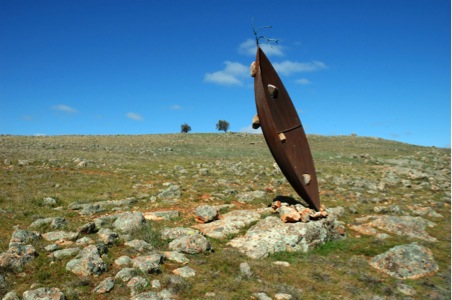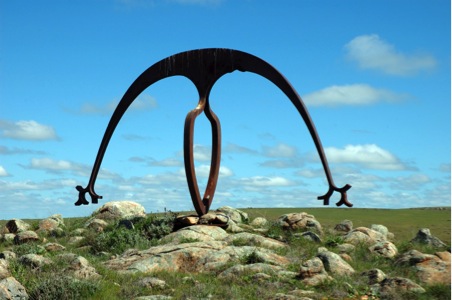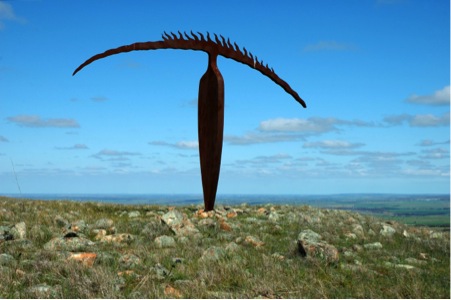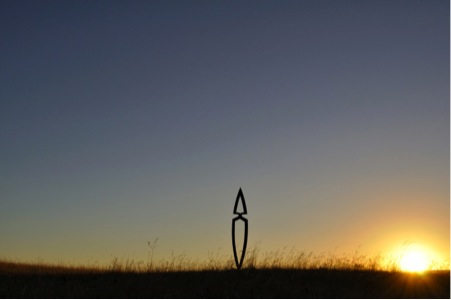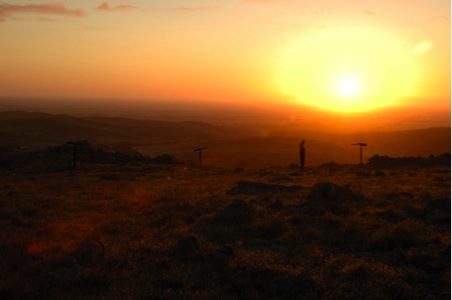The Palmer Sculpture Landscape – Open Days in March
In News March 9, 2017
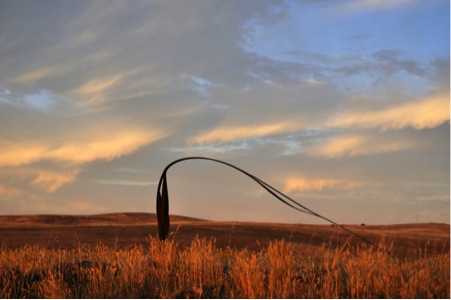
I am interested in engaging with holistic notions, with questions of timelessness, with questions of spirit, with contemporary notions in Physics. My sculptural practice reflects these engagements. These areas of exploration should I feel have a greater role to play in contemporary art practice
‘Palmer, rainshadow country in the Adelaide hills is a fragile landscape reminiscent of the Flinders Ranges. This is not the “pristine” country of the Fleurieu Peninsula. It is tougher, but beautiful in a sense that much of Australia is; where life and death are close neighbours. It is a landscape under revegetation at present. This is a magnificent environment to place sculpture in, big skies, large horizons, open areas, dramatic escarpments, a strong Australian sense of place where a reciprocal dialogue can take place between the sculpture and the landscape. It is a place with both a significant Aboriginal and European history associated with the land. As an Australian sculptor this too attracts me. It is also on the edge, a cusp, the last hills before the extensive Murray Flats. – again sculpturally this attracts me.
More than 35 major sculptures have now been placed at Palmer, They have been carefully placed. They also, deliberately, do not overwhelm the landscape. The Palmer Sculpture and Environmental landscape is a long term project. Two decades will be needed to bring it to its full potential. Already plants/animals are reappearing after a 15 year revegetation program. Sculptures have and will be placed in a considered manner over that time period.
The Palmer Landscape sculptures, installed over the last fifteen years are a mutually respectful engagement between sculpture and the great master from which so much can be learnt, the Australian landscape. The relationship is symbiotic. I hope a sense of form and concept has emerged in my work since about 1990 which is Australian in feel. My reading of the Australian landscape is both a visual and felt one. The felt aspect is expressed symbolically. Symbolism is a bridge between the verbal and that which cannot be expressed verbally. It provides access to the timeless. As such it is a truly useful tool for interpreting the timeless Australian landscape. My sculptures too cannot be interpreted fully without taking a symbolic approach to reading them. It is interesting that symbolism has become such an unapproachable subject in contemporary art making, but then so has the subject of timeless art making and of questions of spirit.
These subjects do not sit well with the Postmodernist, Positive Nihilist, Intellectual Relativism notions of recent decades. Contemporary Art making only rarely escapes these paradigms. Peter Timms in his book “What`s Wrong With Contemporary Art” asks the very pertinent question – ‘why has symbolism become such an enemy of contemporary art making?’ The book created a lot of heated discussion; it questioned many of the operating paradigms of contemporary art. This is not to say all contemporary art is bad. The broadening of sculptural practice in terms of materials used and the greatly expanded ways sculpture can be shown (Installations) are all positives. At the same time I do find the dominant paradigms of the last few decades just mentioned, Post Modernism, Positive Nihilism and the pursuit of the intellectual for the sake of the intellectual (Intellectual Relativism) limiting. I find the leading edge developments in Holistic areas far more interesting. I believe in areas such as Philosophy, Psychology, questions of spirit and to some extent the Sciences holistic research leads the way in understanding both the interior world of the individual human and what lies outside each individual.
Unashamedly I am interested in engaging with holistic notions, with questions of timelessness, with questions of spirit, with contemporary notions in Physics. My sculptural practice reflects these engagements. These areas of exploration should I feel have a greater role to play in contemporary art practice.
I also acknowledge sculptors who have come before me such as Brancusi, Moore, Chillida, Noguchi, Ingre King, Owen Broughton and the extraordinary traditions out of Africa and the New Hebrides. I welcome the tag of being an historical sculptor, even though it is used as a derisive one quite often in relation to my work.
The engagement with the Palmer landscape has provided me with an opportunity to further develop sculpture influenced by this place, Australia. This is a new environment and situation for my mob, the recent invaders/ colonizers, so different to Europe. In a place which contrasts so dramatically with Europe a different sculptural aesthetic should arise, one that is a hybrid of incoming European influences, as well as influences from Australia (both pre and post invasion/colonization).
I hope the Palmer sculptures interwoven with the Palmer landscape contribute to the development of Australian sculpture. I also hope that the sculptures placed there add, both conceptually and visually, another new and different chapter to the extraordinarily diverse, ever changing, ever emerging story of sculpture worldwide’.
Greg Johns, February 2017
There is a wonderful opportunity to spend the day exploring the Palmer Sculpture Landscape with artist Greg Johns at 3pm on Sunday March 12 2017.
This dynamic solo exhibition features more than 40 works and will include a tour and discussion of the sculptures and the landscape, in the rain shadow of the Mount Lofty Ranges, about 70 km east of Adelaide, South Australia.
To be opened by Stuart Purves, National Director Australian Galleries.
Guests Speakers: Tracey Lock, Curator Paintings and Sculpture, Art Gallery of South Australia, Andrew Allanson, Environmentalist and Trent Porter, Environmentalist.
Palmer Sculpture Landscape will also be open on Sunday March 19 and Sunday March 26 from 2pm to 5pm for tours and discussion.
Email gjoh4899@bigpond.net.au for further details or visit https://www.gregjohnssculpture.com/palmer
